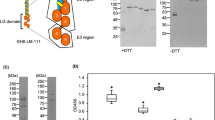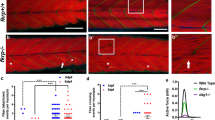Abstract
Dystroglycan is a highly glycosylated extracellular matrix receptor with essential functions in skeletal muscle and the nervous system. Reduced matrix binding by α-dystroglycan (α-DG) due to perturbed glycosylation is a pathological feature of several forms of muscular dystrophy. Like-acetylglucosaminyltransferase (LARGE) synthesizes the matrix-binding heteropolysaccharide [-glucuronic acid-β1,3-xylose-α1,3-]n. Using a dual exoglycosidase digestion, we confirm that this polysaccharide is present on native α-DG from skeletal muscle. The atomic details of matrix binding were revealed by a high-resolution crystal structure of laminin-G-like (LG) domains 4 and 5 (LG4 and LG5) of laminin-α2 bound to a LARGE-synthesized oligosaccharide. A single glucuronic acid-β1,3-xylose disaccharide repeat straddles a Ca2+ ion in the LG4 domain, with oxygen atoms from both sugars replacing Ca2+-bound water molecules. The chelating binding mode accounts for the high affinity of this protein–carbohydrate interaction. These results reveal a previously uncharacterized mechanism of carbohydrate recognition and provide a structural framework for elucidating the mechanisms underlying muscular dystrophy.
This is a preview of subscription content, access via your institution
Access options
Subscribe to this journal
Receive 12 print issues and online access
$259.00 per year
only $21.58 per issue
Buy this article
- Purchase on Springer Link
- Instant access to full article PDF
Prices may be subject to local taxes which are calculated during checkout





Similar content being viewed by others
References
Ervasti, J.M. & Campbell, K.P. A role for the dystrophin-glycoprotein complex as a transmembrane linker between laminin and actin. J. Cell Biol. 122, 809–823 (1993).
Ibraghimov-Beskrovnaya, O. et al. Primary structure of dystrophin-associated glycoproteins linking dystrophin to the extracellular matrix. Nature 355, 696–702 (1992).
Michele, D.E. et al. Post-translational disruption of dystroglycan-ligand interactions in congenital muscular dystrophies. Nature 418, 417–422 (2002).
Cohn, R.D. et al. Disruption of DAG1 in differentiated skeletal muscle reveals a role for dystroglycan in muscle regeneration. Cell 110, 639–648 (2002).
Moore, S.A. et al. Deletion of brain dystroglycan recapitulates aspects of congenital muscular dystrophy. Nature 418, 422–425 (2002).
Satz, J.S. et al. Distinct functions of glial and neuronal dystroglycan in the developing and adult mouse brain. J. Neurosci. 30, 14560–14572 (2010).
Barresi, R. & Campbell, K.P. Dystroglycan: from biosynthesis to pathogenesis of human disease. J. Cell Sci. 119, 199–207 (2006).
Yurchenco, P.D. Basement membranes: cell scaffoldings and signaling platforms. Cold Spring Harb. Perspect. Biol. 3, a004911 (2011).
Godfrey, C., Foley, A.R., Clement, E. & Muntoni, F. Dystroglycanopathies: coming into focus. Curr. Opin. Genet. Dev. 21, 278–285 (2011).
Sugita, S. et al. A stoichiometric complex of neurexins and dystroglycan in brain. J. Cell Biol. 154, 435–445 (2001).
Sato, S. et al. Pikachurin, a dystroglycan ligand, is essential for photoreceptor ribbon synapse formation. Nat. Neurosci. 11, 923–931 (2008).
Wright, K.M. et al. Dystroglycan organizes axon guidance cue localization and axonal pathfinding. Neuron 76, 931–944 (2012).
Cao, W. et al. Identification of α-dystroglycan as a receptor for lymphocytic choriomeningitis virus and Lassa fever virus. Science 282, 2079–2081 (1998).
Jae, L.T. et al. Deciphering the glycosylome of dystroglycanopathies using haploid screens for lassa virus entry. Science 340, 479–483 (2013).
Yoshida-Moriguchi, T. & Campbell, K.P. Matriglycan: a novel polysaccharide that links dystroglycan to the basement membrane. Glycobiology 25, 702–713 (2015).
Yoshida-Moriguchi, T. et al. SGK196 is a glycosylation-specific O-mannose kinase required for dystroglycan function. Science 341, 896–899 (2013).
Yoshida-Moriguchi, T. et al. O-mannosyl phosphorylation of α-dystroglycan is required for laminin binding. Science 327, 88–92 (2010).
Kanagawa, M. et al. Identification of a post-translational modification with ribitol-phosphate and its defect in muscular dystrophy. Cell Rep. 14, 2209–2223 (2016).
Inamori, K. et al. Dystroglycan function requires xylosyl- and glucuronyltransferase activities of LARGE. Science 335, 93–96 (2012).
Goddeeris, M.M. et al. LARGE glycans on dystroglycan function as a tunable matrix scaffold to prevent dystrophy. Nature 503, 136–140 (2013).
Grewal, P.K., Holzfeind, P.J., Bittner, R.E. & Hewitt, J.E. Mutant glycosyltransferase and altered glycosylation of alpha-dystroglycan in the myodystrophy mouse. Nat. Genet. 28, 151–154 (2001).
Longman, C. et al. Mutations in the human LARGE gene cause MDC1D, a novel form of congenital muscular dystrophy with severe mental retardation and abnormal glycosylation of α-dystroglycan. Hum. Mol. Genet. 12, 2853–2861 (2003).
Rudenko, G., Hohenester, E. & Muller, Y.A. LG/LNS domains: multiple functions -- one business end? Trends Biochem. Sci. 26, 363–368 (2001).
Hohenester, E., Tisi, D., Talts, J.F. & Timpl, R. The crystal structure of a laminin G-like module reveals the molecular basis of α-dystroglycan binding to laminins, perlecan, and agrin. Mol. Cell 4, 783–792 (1999).
Wizemann, H. et al. Distinct requirements for heparin and α-dystroglycan binding revealed by structure-based mutagenesis of the laminin α2 LG4-LG5 domain pair. J. Mol. Biol. 332, 635–642 (2003).
Salleh, H.M. et al. Cloning and characterization of Thermotoga maritima β-glucuronidase. Carbohydr. Res. 341, 49–59 (2006).
Moracci, M. et al. Identification and molecular characterization of the first α -xylosidase from an archaeon. J. Biol. Chem. 275, 22082–22089 (2000).
Smirnov, S.P. et al. Contributions of the LG modules and furin processing to laminin-2 functions. J. Biol. Chem. 277, 18928–18937 (2002).
Talts, J.F., Andac, Z., Göhring, W., Brancaccio, A. & Timpl, R. Binding of the G domains of laminin α1 and α2 chains and perlecan to heparin, sulfatides, α-dystroglycan and several extracellular matrix proteins. EMBO J. 18, 863–870 (1999).
DeLucas, L. & Bugg, C.E. Calcium binding to D-glucuronate residues: crystal structure of a hydrated calcium bromide salt of D-glucuronic acid. Carbohydr. Res. 41, 18–29 (1975).
Feinberg, H., Castelli, R., Drickamer, K., Seeberger, P.H. & Weis, W.I. Multiple modes of binding enhance the affinity of DC-SIGN for high mannose N-linked glycans found on viral glycoproteins. J. Biol. Chem. 282, 4202–4209 (2007).
Nagae, M. & Yamaguchi, Y. Three-dimensional structural aspects of protein-polysaccharide interactions. Int. J. Mol. Sci. 15, 3768–3783 (2014).
Timpl, R. et al. Structure and function of laminin LG modules. Matrix Biol. 19, 309–317 (2000).
Reissner, C. et al. Dystroglycan binding to α-neurexin competes with neurexophilin-1 and neuroligin in the brain. J. Biol. Chem. 289, 27585–27603 (2014).
Harrison, D. et al. Crystal structure and cell surface anchorage sites of laminin α1LG4-5. J. Biol. Chem. 282, 11573–11581 (2007).
Weis, W.I. & Drickamer, K. Structural basis of lectin-carbohydrate recognition. Annu. Rev. Biochem. 65, 441–473 (1996).
Somers, W.S., Tang, J., Shaw, G.D. & Camphausen, R.T. Insights into the molecular basis of leukocyte tethering and rolling revealed by structures of P- and E-selectin bound to SLe(X) and PSGL-1. Cell 103, 467–479 (2000).
Gesemann, M. et al. Alternative splicing of agrin alters its binding to heparin, dystroglycan, and the putative agrin receptor. Neuron 16, 755–767 (1996).
Hara, Y. et al. Like-acetylglucosaminyltransferase (LARGE)-dependent modification of dystroglycan at Thr-317/319 is required for laminin binding and arenavirus infection. Proc. Natl. Acad. Sci. USA 108, 17426–17431 (2011).
Vester-Christensen, M.B. et al. Mining the O-mannose glycoproteome reveals cadherins as major O-mannosylated glycoproteins. Proc. Natl. Acad. Sci. USA 110, 21018–21023 (2013).
Kanagawa, M. et al. Molecular recognition by LARGE is essential for expression of functional dystroglycan. Cell 117, 953–964 (2004).
Stetefeld, J. et al. Modulation of agrin function by alternative splicing and Ca2+ binding. Structure 12, 503–515 (2004).
Le, B.V. et al. Crystal structure of the LG3 domain of endorepellin, an angiogenesis inhibitor. J. Mol. Biol. 414, 231–242 (2011).
Sheckler, L.R., Henry, L., Sugita, S., Südhof, T.C. & Rudenko, G. Crystal structure of the second LNS/LG domain from neurexin 1α: Ca2+ binding and the effects of alternative splicing. J. Biol. Chem. 281, 22896–22905 (2006).
Chen, F., Venugopal, V., Murray, B. & Rudenko, G. The structure of neurexin 1α reveals features promoting a role as synaptic organizer. Structure 19, 779–789 (2011).
Combs, A.C. & Ervasti, J.M. Enhanced laminin binding by α-dystroglycan after enzymatic deglycosylation. Biochem. J. 390, 303–309 (2005).
Beedle, A.M., Nienaber, P.M. & Campbell, K.P. Fukutin-related protein associates with the sarcolemmal dystrophin-glycoprotein complex. J. Biol. Chem. 282, 16713–16717 (2007).
Kohfeldt, E., Maurer, P., Vannahme, C. & Timpl, R. Properties of the extracellular calcium binding module of the proteoglycan testican. FEBS Lett. 414, 557–561 (1997).
Paracuellos, P., Briggs, D.C., Carafoli, F., Lončar, T. & Hohenester, E. Insights into collagen uptake by C-type mannose receptors from the crystal structure of Endo180 domains 1-4. Structure 23, 2133–2142 (2015).
Winter, G., Lobley, C.M. & Prince, S.M. Decision making in xia2. Acta Crystallogr. D Biol. Crystallogr. 69, 1260–1273 (2013).
Karplus, P.A. & Diederichs, K. Linking crystallographic model and data quality. Science 336, 1030–1033 (2012).
McCoy, A.J. et al. Phaser crystallographic software. J. Appl. Crystallogr. 40, 658–674 (2007).
Tisi, D., Talts, J.F., Timpl, R. & Hohenester, E. Structure of the C-terminal laminin G-like domain pair of the laminin α2 chain harbouring binding sites for α-dystroglycan and heparin. EMBO J. 19, 1432–1440 (2000).
Emsley, P. & Cowtan, K. Coot: model-building tools for molecular graphics. Acta Crystallogr. D Biol. Crystallogr. 60, 2126–2132 (2004).
Adams, P.D. et al. PHENIX: a comprehensive Python-based system for macromolecular structure solution. Acta Crystallogr. D Biol. Crystallogr. 66, 213–221 (2010).
Chen, V.B. et al. MolProbity: all-atom structure validation for macromolecular crystallography. Acta Crystallogr. D Biol. Crystallogr. 66, 12–21 (2010).
Mayer, M. & Meyer, B. Group epitope mapping by saturation transfer difference NMR to identify segments of a ligand in direct contact with a protein receptor. J. Am. Chem. Soc. 123, 6108–6117 (2001).
Nyberg, N.T., Duus, J.O. & Sørensen, O.W. Editing of H2BC NMR spectra. Magn. Reson. Chem. 43, 971–974 (2005).
Delaglio, F. et al. NMRPipe: a multidimensional spectral processing system based on UNIX pipes. J. Biomol. NMR 6, 277–293 (1995).
Johnson, B.A. & Blevins, R.A. NMR View: a computer program for the visualization and analysis of NMR data. J. Biomol. NMR 4, 603–614 (1994).
Acknowledgements
We thank S.G. Withers (University of British Columbia) for a gift of T. maritima β-glucuronidase and C.M. Blaumueller for critical reading of the manuscript. The IIH6 antibody was obtained from the Developmental Studies Hybridoma Bank, University of Iowa. We acknowledge Diamond Light Source for time on beamlines I02 and I04-1 under proposal MX9424. This work was funded by a Wellcome Trust Senior Investigator Award to E.H. (101748/Z/13/Z) and a Paul D. Wellstone Muscular Dystrophy Cooperative Research Center grant to K.P.C. (1U54NS053672).
Author information
Authors and Affiliations
Contributions
D.C.B. co-designed the project, carried out the crystallographic experiments, analyzed the data and co-wrote the manuscript. T.Y.-M. produced xylosidase and glucuronidase, and performed enzyme digestions and binding assays. T.Z. generated the reagent X2, produced xylosidase and glucuronidase, and performed the G5 digestion experiment. D.V. generated reagents G3, G5 and G6/7. M.A. performed enzyme digestions and western blotting. A.S. and M.M. provided well-characterized xylosidase. L.Y. carried out the NMR experiments and analyzed the data. E.H. and K.P.C. co-designed the project, co-wrote the manuscript and supervised the research. All authors discussed the results and commented on the manuscript.
Corresponding authors
Ethics declarations
Competing interests
The authors declare no competing financial interests.
Supplementary information
Supplementary Text and Figures
Supplementary Results, Supplementary Tables 1 and 2 and Supplementary Figures 1–7. (PDF 5119 kb)
Rights and permissions
About this article
Cite this article
Briggs, D., Yoshida-Moriguchi, T., Zheng, T. et al. Structural basis of laminin binding to the LARGE glycans on dystroglycan. Nat Chem Biol 12, 810–814 (2016). https://doi.org/10.1038/nchembio.2146
Received:
Accepted:
Published:
Issue Date:
DOI: https://doi.org/10.1038/nchembio.2146
This article is cited by
-
Cell surface glycan engineering reveals that matriglycan alone can recapitulate dystroglycan binding and function
Nature Communications (2022)
-
The role of protein glycosylation in muscle diseases
Molecular Biology Reports (2022)
-
Profiling of the muscle-specific dystroglycan interactome reveals the role of Hippo signaling in muscular dystrophy and age-dependent muscle atrophy
BMC Medicine (2020)
-
Eyes shut homolog (EYS) interacts with matriglycan of O-mannosyl glycans whose deficiency results in EYS mislocalization and degeneration of photoreceptors
Scientific Reports (2020)
-
Crystal structures of fukutin-related protein (FKRP), a ribitol-phosphate transferase related to muscular dystrophy
Nature Communications (2020)



